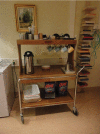Family members´ experiences of the end-of-life care environments in acute care settings - a photo-elicitation study
- PMID: 30176152
- PMCID: PMC6127834
- DOI: 10.1080/17482631.2018.1511767
Family members´ experiences of the end-of-life care environments in acute care settings - a photo-elicitation study
Erratum in
-
Correction.Int J Qual Stud Health Well-being. 2018 Dec;13(1):1546359. doi: 10.1080/17482631.2018.1546359. Int J Qual Stud Health Well-being. 2018. PMID: 30521422 Free PMC article. No abstract available.
Abstract
Purpose: This article explores experiences of the acute-care environment as a setting for end-of-life (EoL) care from the perspective of family members of a dying person.
Method: We used participant-produced photographs in conjunction with follow-up interviews with nine family members to persons at the EoL, cared for in two acute-care settings.
Results: The interpretive description analysis process resulted in three constructed themes-Aesthetic and un-aesthetic impressions, Space for privacy and social relationships, and Need for guidance in crucial times. Aspects of importance in the physical setting related to aesthetics, particularly in regard to sensory experience, and to a need for enough privacy to facilitate the maintenance of social relationships. Interactions between the world of family members and that of professionals were described as intrinsically related to guidance about both the material and immaterial environment at crucial times.
Conclusion: The care environment, already recognized to have an impact in relation to patients, is concluded to also affect the participating family members in this study in a variety of ways.
Keywords: Acute care; care environment; end-of-life; family members; hospital; photo-elicitation; visual research methods.
Figures









Similar articles
-
Beyond the visual and verbal: Using participant-produced photographs in research on the surroundings for care at the end-of-life.Soc Sci Med. 2016 Nov;168:120-129. doi: 10.1016/j.socscimed.2016.09.012. Epub 2016 Sep 10. Soc Sci Med. 2016. PMID: 27643846
-
[End-of-Life Care in Intensive Care Units: Nursing strategies of family involvement at the end of life].Pflege. 2018 Jun;31(3):135-143. doi: 10.1024/1012-5302/a000615. Epub 2018 Mar 29. Pflege. 2018. PMID: 29592534 German.
-
Family experiences of hospital end-of-life care in Switzerland: an interpretive phenomenological study.Int J Palliat Nurs. 2009 Jul;15(7):332-7. doi: 10.12968/ijpn.2009.15.7.43423. Int J Palliat Nurs. 2009. PMID: 19648848
-
Privacy at end of life in ICU: A review of the literature.J Clin Nurs. 2018 Jun;27(11-12):2274-2284. doi: 10.1111/jocn.14279. Epub 2018 Mar 26. J Clin Nurs. 2018. PMID: 29399904 Review.
-
Caring for the dying patient in the ICU--the past, the present and the future.Intensive Crit Care Nurs. 2014 Dec;30(6):306-11. doi: 10.1016/j.iccn.2014.07.004. Epub 2014 Sep 11. Intensive Crit Care Nurs. 2014. PMID: 25218688 Review.
Cited by
-
Family-Centered Care Experiences in Elderly with Chronic Diseases in Communities: Qualitative Study of Patients, Families, Nurses, and Volunteers.Health Equity. 2024 Jun 5;8(1):338-350. doi: 10.1089/heq.2024.0009. eCollection 2024. Health Equity. 2024. PMID: 39011075 Free PMC article.
-
The viability and appropriateness of using visual methods in end of life research to foreground the experiences of people affected by financial hardship and deprivation.Palliat Med. 2023 Apr;37(4):627-637. doi: 10.1177/02692163221146590. Epub 2023 Jan 6. Palliat Med. 2023. PMID: 36609208 Free PMC article.
-
Support received by family members before, at and after an ill person's death.BMC Palliat Care. 2021 Jun 24;20(1):92. doi: 10.1186/s12904-021-00800-8. BMC Palliat Care. 2021. PMID: 34167530 Free PMC article.
-
Expectation, emotion and the built environment: experiences of occupying hospital spaces as a loved one nears the end of life.Med Humanit. 2025 Feb 24;51(1):86-95. doi: 10.1136/medhum-2024-012989. Med Humanit. 2025. PMID: 39216987 Free PMC article.
-
Emergency nurses' experiences of caring for brought-in-dead persons and their relatives-a qualitative study.J Adv Nurs. 2025 Mar;81(3):1543-1553. doi: 10.1111/jan.16371. Epub 2024 Aug 6. J Adv Nurs. 2025. PMID: 39104304 Free PMC article.
References
-
- Al-Qurainy R., Collis E., & Feuer D. (2009). Dying in an acute hospital setting: The challenges and solutions. International Journal of Clinical Practice, 63(3), 508–15. - PubMed
-
- Andrade, C. C., Lima, M. L., Devlin, A. S., & Hernandez, B. (2016). Is It the Place or the People? Disentangling the Effects of Hospitals' Physical and Social Environments on Well-Being. Environment and Behavior, 48(2), 299–323. doi:10.1177/0013916514536182 - DOI
-
- Balmer C., Griffiths F., & Dunn J. (2015). A review of the issues and challenges involved in using participant-produced photographs in nursing research. Journal of Advanced Nursing, 71(7), 1726–1737. - PubMed
-
- Beckstrand R. L., Rasmussen R. J., Luthy K. E., & Heaston S. (2012). Emergency nurses’ perception of department design as an obstacle to providing end-of-life care. Journal of Emergency Nursing, 38(5), E27–E32. - PubMed
MeSH terms
LinkOut - more resources
Full Text Sources
Other Literature Sources
Medical
